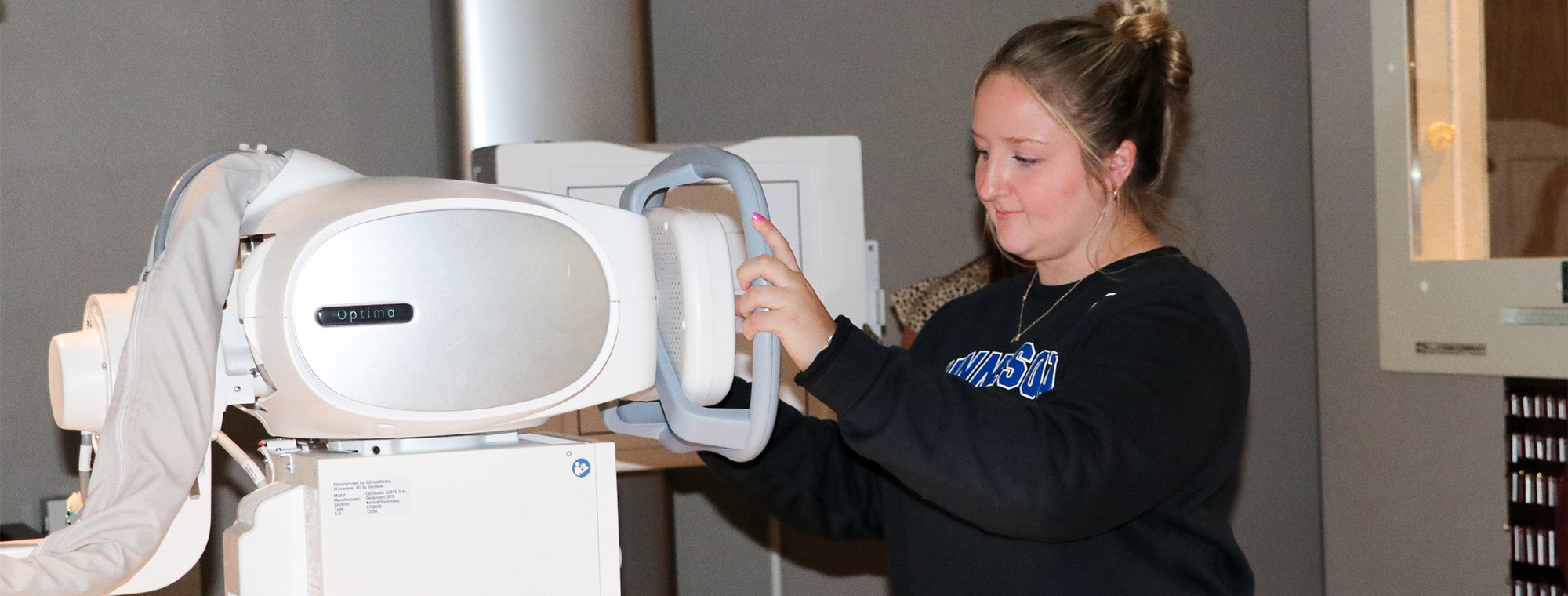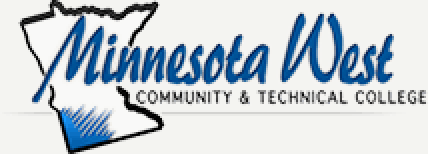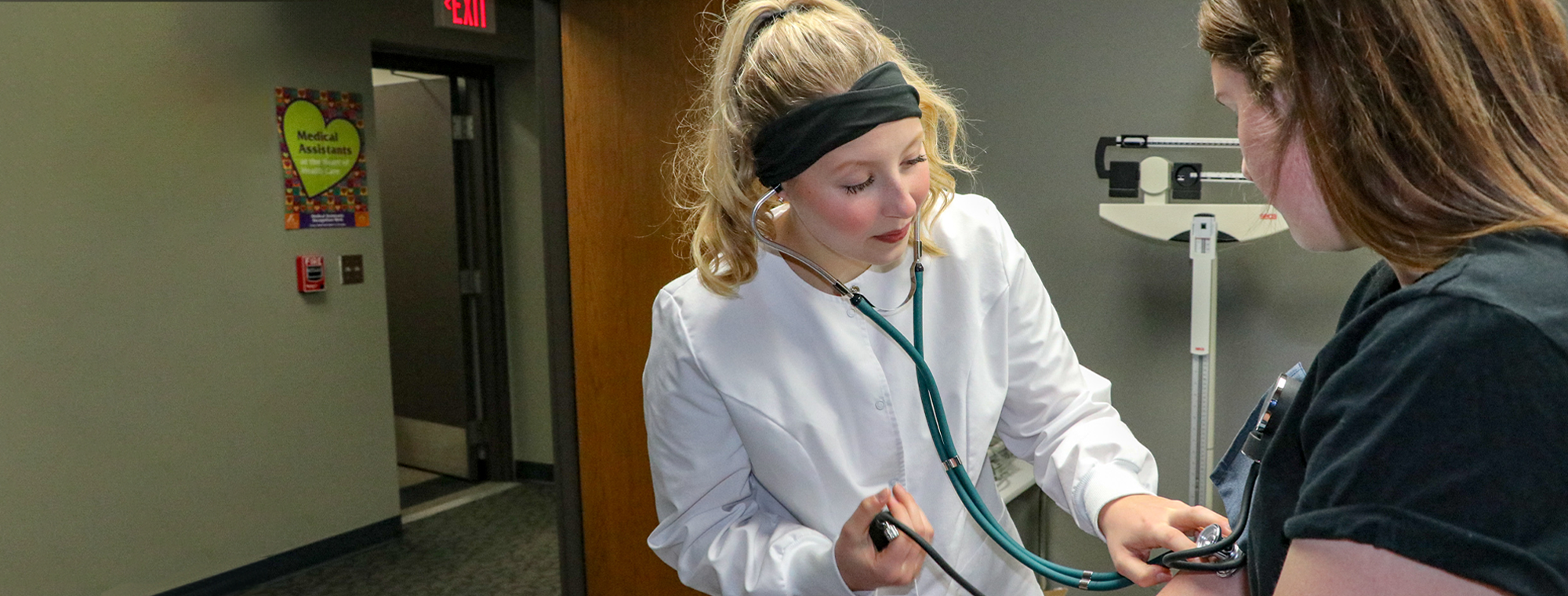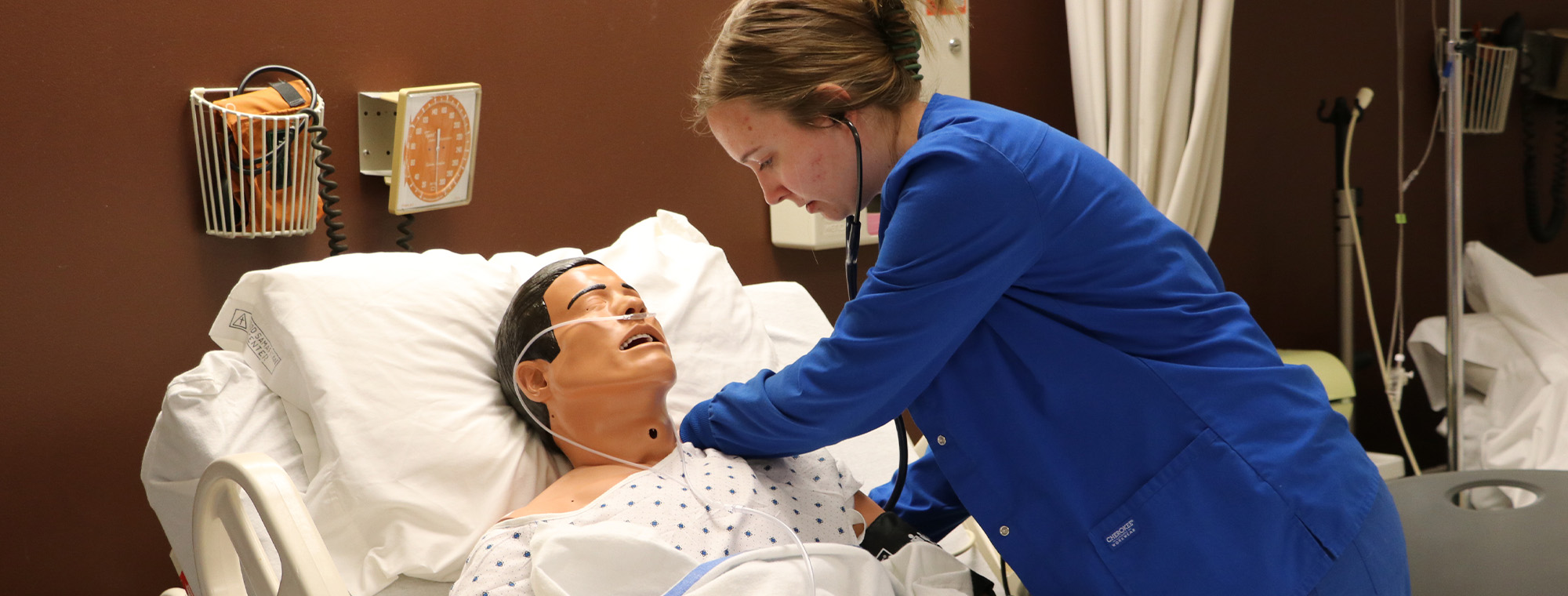Radiologic Technology

Radiologic technologists are vital healthcare professionals who perform diagnostic imaging examinations, such as X-rays, MRIs, and CT scans. They work closely with physicians to ensure accurate imaging that aids in patient diagnosis and treatment. With opportunities in hospitals, clinics, and specialized imaging centers, this field offers a stable career path with potential for advancement into roles such as imaging supervisors, educators or in sales. It is a rewarding job that plays an important role in helping people stay healthy!
Accreditated program
hands-on training through classroom and clinical experience
100% job placement rate
This Program is Available at:
Choose your path

Radiologic Technology, A.A.S.
Length
- 2 Years for Full-Time Students
- 84 Credits
Course List
Application Dates
Application period for fall semester begins Monday, Dec. 2, 2024.
Deadline to apply is January 15.
Admission Guidelines
The Radiologic Technology Program begins once a year at the beginning of the fall semester. The radiography curriculum is two years (24 continuous months) in length and graduates are awarded an Associate of Applied Science Degree (A.A.S). Many radiography students choose to complete their general education credits prior to beginning the program courses.
Application Process
-
Apply to Minnesota West and indicate Radiologic Technology as a program major.
- Complete the online Radiologic Technology Program Application, indicating the year you wish to start.
-
Transcripts: Official high school and college transcripts must be sent directly to the Luverne Campus. If you previously attended an institution that is part of the Minnesota State Colleges and Universities system, you may not need to request a transcript. If you apply online, you will be notified immediately if you need to request your own transcript manually. The Registrar will evaluate transcripts for course currency upon admission to the program.
-
Optional supplemental assessment material includes submitting official ACT results.
-
Assessment Testing: Minnesota West has mandatory placement in courses based on the Accuplacer. Test information and sample questions are available for your review purposes. This test can be scheduled through the Luverne Center by calling 507-449-2772.
The Radiologic Technology Program begins once a year at the beginning of the fall semester. The radiography curriculum is two years (24 continuous months) in length and graduates are awarded an Associate of Applied Science Degree (A.A.S.). Many radiography students choose to complete their general education credits prior to beginning the program courses.
In addition to the classroom coursework, students will also be assigned to clinical settings throughout the region for completion of their clinical courses. Clinical settings range from hospital to clinic settings throughout southwest Minnesota, southeast South Dakota and northwest Iowa. Many clinical settings are within 60 miles of Luverne; however, some sites are up to 120 miles away. Students will be assigned to their clinical setting by the clinical coordinator. Clinical hours will consist of approximately 30-40 hours per week.
Students will rotate between one semester of class followed by a semester of clinicals. While students are in clinicals they will switch between five days a week and four days a week, consisting of 8-hour shifts. They will rotate through up to five clinical sites throughout the duration of the program with the option of one being an evening shift with the hours of 2:00 - 10:00 p.m.
All prerequisite courses are available at any Minnesota West campus or center and online. All prerequisites must be completed prior to starting the program.
- Successful completion of BIOL 2245, Medical Terminology, or equivalent transfer course.
- Successful completion of RADT 1105, Radiographic Basics.
- Successful completion of BIOL 2201, Anatomy, or equivalent transfer course.
Admission to the Radiologic Technology program is competitive. Applicants who have met the minimum admission requirements by the deadline will be reviewed for admission to the program.
Admission to the program is determined by a screening committee based on the following criteria:
- Applicants will be scored and ranked by number.
- Applicants will be given points for each prerequisite and general education course completed and will also be granted points for their respective GPAs.
- Students who have previously applied to the program and/or who have completed observation in a radiology department will also be granted points.
- Students have the option of submitting their official ACT scores. Students will be awarded points if they choose to submit; however, they are not required.
- Students with the highest number of points will be accepted into the program.
See Applicant Assessment Score Sheet.
Written notification will be sent in March to all applicants. The accepted students will be required to attend a mandatory orientation in April in order to maintain their position in the program.
All accepted students will be required to pass two background studies in order to be placed into clinicals and to sit for the national ARRT board exam upon completion of the program. Details will be discussed at the orientation. See below for information on the required background studies.
Minnesota Law requires any person who provides a service that involves direct contact with patients and residents in healthcare facilities licensed by the Minnesota Department of Health to have a background study conducted by the state. An individual who is disqualified from having direct patient contact as a result of a background study, and whose disqualification is not set aside by the Commissioner of Health, will not be permitted to participate in a clinical placement in a Minnesota-licensed health care facility. Failure to participate in a clinical placement required by the academic program will result in ineligibility to qualify for a degree in the program.
When determining eligibility for examination, the ARRT requires that the applicant be of good moral character. Conviction of a crime, including a felony or a gross misdemeanor, with the sole exception of speeding and parking violations is considered to be a violation of the Standards of Ethics. Such violations must be cleared by the ARRT before the applicant can be assigned to an examination. The ARRT Ethics Pre-Application Review is reserved for those who:
- are not enrolled in an ARRT-recognized education program, or
- are more than six months away from graduating from an ARRT-recognized education program.
The radiographer assists the radiologist in the diagnosis of illness, disease and injury. As a part of the medical team, the radiographer is involved in traditional x-ray exams, surgery, emergency care, and fluoroscopic examinations. Graduates will find employment opportunities in hospitals, clinics and other healthcare facilities. Currently, the job market is extremely promising, jobs within technical healthcare are growing at a rate much higher than average. A large percentage of our graduates gain employment at our clinical sites.
The mission of the Minnesota West Community & Technical College’s Radiologic Technology Program is to meet or exceed the JRCERT standards and prepare individuals with the necessary knowledge and skills required of an entry-level Radiologic Technologist. Through the process of continuous improvement, the program faculty and clinical affiliates will provide access to quality radiographic technologists.
The program will continuously evaluate program effectiveness.
- Students who enroll in the program will complete the program.
- Graduates will pass the ARRT radiography exam.
- Graduates will be satisfied with the program.
- Employers will be satisfied with graduate’s performance.
- Graduates seeking employment will be employed.
The student will be clinically competent.
- The student will demonstrate radiation protection practices.
- The student will demonstrate positioning skills.
- The student will demonstrate ability to use radiographic equipment.
The student will use problemsolving and critical thinking skills.
- The student will evaluate images effectively.
- The students will analyze laboratory experiments and applications.
The students will demonstrate professional and ethical behavior.
- The student will demonstrate basic patient care skills.
- The student will demonstrate age-appropriateness in regards to patient care.
- The student will demonstrate professionalism.
The students will effectively communicate.
- The student will communicate within the healthcare setting.
- The student will demonstrate communication skills.
Minnesota West Community and Technical College Radiologic Technology Program is accredited by:
Higher Learning Commission (HLC)
230 South LaSalle Street / Suite 7-500
Chicago, IL, 60604-1411
800.621.7440 / info@hlcommission.org
Joint Review Committee on Education in Radiologic Technology (JRCERT)
20 North Wacker Drive, Suite 2850
Chicago, Illinois 60606-3182
312-704-5300
The program’s current award is 8 years. General program accreditation information and the current accreditation award letter can be found here.
The tuition estimates include pre-requisite courses and general education credits along with the program credits. The tuition estimate is based on projected rates for 2023-2024.
Tuition & Fees: $18,548
Textbooks-Radiography: $1,000.00
Textbooks-General Education: variable
Miscellaneous Fees: $1,500
ARRT Exam: $225
Uniform/Shoes: $300
Travel & accommodations: variable
**These figures are only estimates of the program. Costs may vary.
Program Effectiveness (5-year average)
ARRT Board Pass Rate - First attempt 86%
Job Placement Rate - 100%
Program Completion Rate - 82%
Program Completion Rates
This is an annual measurement of the number of students that began the program divided by the number of students that actually completed the program. The program’s completion rate for the class of 2024 was 82%. 14 of the 17 students who were expected to complete the program in 2024 went on to complete the program that year. The program's five-year average (2020-2024) completion rate is 78% as 76 students started the program and 59 completed it.
ARRT Board Pass Rate
This rate is the number of students that pass the American Registry of Radiologic Technologists (ARRT) national credentialing exam on the first attempt. In 2023, 14 students took the exam and 12 students passed the exam on the first attempt, giving the program a 86% board pass rate for 2023. The five-year average (2019-2023) for the program’s ARRT board pass rate is 86% as 58 students have taken the exam and 50 students have passed upon first attempt.
Job Placement
This is the number of students who gain employment in the radiologic technology field within 12 months of graduation versus the number of students who graduate and are actively seeking employment. Of those students graduating in 2023, 14 students graduated and were actively seeking employment. All 14 of the students were employed within 12 months of graduation, giving the program 100% job placement rate for the year. Overall, the program has an average job placement rate of 100% for those graduating in 2019-2023. In all, 56 graduates have been actively seeking employment and 56 have gained employment within the recommended timeframe according to the JRCERT standards
For more information
Joint Review Committee on Education in Radiologic Technology (JRCERT)
Career Opportunities
Radiographers use X-rays to create digital images of the patient's anatomy. They help detect bone fractures, locate foreign objects, and show the relationship between bone and soft tissue.
CT Technologists use a rotating X-ray machine to capture slices of the body's anatomy. CT scans allow doctors to see inside organs layer by layer, unlike general X-rays.
Radiologist Assistants are trained radiographers with additional education and certification. They work under a radiologist's supervision, providing advanced patient care, conducting imaging tests, and sharing initial observations with the supervising radiologist.


